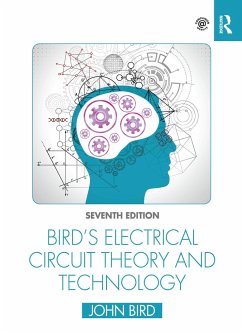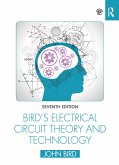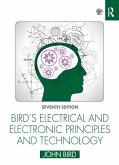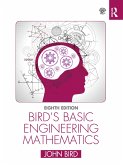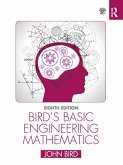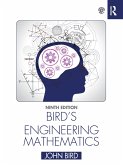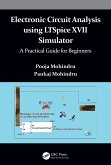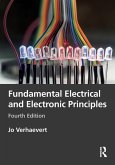John Bird (UK Defence College of Technical Training)
Bird's Electrical Circuit Theory and Technology
John Bird (UK Defence College of Technical Training)
Bird's Electrical Circuit Theory and Technology
- Gebundenes Buch
- Merkliste
- Auf die Merkliste
- Bewerten Bewerten
- Teilen
- Produkt teilen
- Produkterinnerung
- Produkterinnerung
This undergraduate and advanced pre-degree textbook includes 850 worked examples. Now with glass batteries, climate change and the future of electricity production. Its companion website includes multiple choice tests, laboratory experiments, and 1400 questions and solutions.
Andere Kunden interessierten sich auch für
![Bird's Electrical Circuit Theory and Technology Bird's Electrical Circuit Theory and Technology]() John Bird (UK Defence College of Technical Training)Bird's Electrical Circuit Theory and Technology69,99 €
John Bird (UK Defence College of Technical Training)Bird's Electrical Circuit Theory and Technology69,99 €![Bird's Electrical and Electronic Principles and Technology Bird's Electrical and Electronic Principles and Technology]() John Bird (UK Defence College of Technical Training)Bird's Electrical and Electronic Principles and Technology53,99 €
John Bird (UK Defence College of Technical Training)Bird's Electrical and Electronic Principles and Technology53,99 €![Bird's Basic Engineering Mathematics Bird's Basic Engineering Mathematics]() John Bird (UK Defence College of Technical Training)Bird's Basic Engineering Mathematics146,99 €
John Bird (UK Defence College of Technical Training)Bird's Basic Engineering Mathematics146,99 €![Bird's Basic Engineering Mathematics Bird's Basic Engineering Mathematics]() John Bird (UK Defence College of Technical Training)Bird's Basic Engineering Mathematics52,99 €
John Bird (UK Defence College of Technical Training)Bird's Basic Engineering Mathematics52,99 €![Bird's Engineering Mathematics Bird's Engineering Mathematics]() John Bird (UK Defence College of Technical Training)Bird's Engineering Mathematics64,99 €
John Bird (UK Defence College of Technical Training)Bird's Engineering Mathematics64,99 €![Electronic Circuit Analysis using LTSpice XVII Simulator Electronic Circuit Analysis using LTSpice XVII Simulator]() Pooja Mohindru (India. Punjabi University)Electronic Circuit Analysis using LTSpice XVII Simulator113,99 €
Pooja Mohindru (India. Punjabi University)Electronic Circuit Analysis using LTSpice XVII Simulator113,99 €![Fundamental Electrical and Electronic Principles Fundamental Electrical and Electronic Principles]() Jo VerhaevertFundamental Electrical and Electronic Principles55,99 €
Jo VerhaevertFundamental Electrical and Electronic Principles55,99 €-
-
-
This undergraduate and advanced pre-degree textbook includes 850 worked examples. Now with glass batteries, climate change and the future of electricity production. Its companion website includes multiple choice tests, laboratory experiments, and 1400 questions and solutions.
Hinweis: Dieser Artikel kann nur an eine deutsche Lieferadresse ausgeliefert werden.
Hinweis: Dieser Artikel kann nur an eine deutsche Lieferadresse ausgeliefert werden.
Produktdetails
- Produktdetails
- Verlag: Taylor & Francis Ltd
- 7 ed
- Seitenzahl: 912
- Erscheinungstermin: 1. Oktober 2021
- Englisch
- Abmessung: 217mm x 286mm x 52mm
- Gewicht: 2852g
- ISBN-13: 9780367672249
- ISBN-10: 0367672243
- Artikelnr.: 62234306
- Herstellerkennzeichnung
- Libri GmbH
- Europaallee 1
- 36244 Bad Hersfeld
- gpsr@libri.de
- Verlag: Taylor & Francis Ltd
- 7 ed
- Seitenzahl: 912
- Erscheinungstermin: 1. Oktober 2021
- Englisch
- Abmessung: 217mm x 286mm x 52mm
- Gewicht: 2852g
- ISBN-13: 9780367672249
- ISBN-10: 0367672243
- Artikelnr.: 62234306
- Herstellerkennzeichnung
- Libri GmbH
- Europaallee 1
- 36244 Bad Hersfeld
- gpsr@libri.de
John Bird, BSc (Hons), CEng, CMath, CSci, FIMA, FIET, FCollT, is the former Head of Applied Electronics in the Faculty of Technology at Highbury College, Portsmouth, UK. More recently, he has combined freelance lecturing at the University of Portsmouth, with Examiner responsibilities for Advanced Mathematics with City and Guilds and examining for the International Baccalaureate Organisation. He has over 45 years' experience of successfully teaching, lecturing, instructing, training, educating, and planning of trainee engineers study programmes. He is the author of 146 textbooks on engineering, science, and mathematical subjects, with worldwide sales of over one million copies. He is a chartered engineer, a chartered mathematician, a chartered scientist and a Fellow of three professional institutions. He has recently retired from lecturing at the Royal Navy's Defence College of Marine Engineering in the Defence College of Technical Training at H.M.S. Sultan, Gosport, Hampshire, UK, one of the largest engineering training establishments in Europe.
Section 1 Revision of Some Basic Mathematics 1. Some Mathematics Revisio 2.
Further Mathematics Revision Section 2 Basic Electrical and Electronic
Engineering Principles 3. Units associated with basic electrical quantities
4. An introduction to electric circuits 5. Resistance variation 6.
Batteries and alternative sources of energy 7. Series and parallel networks
8. Capacitors and capacitance 9. Magnetic circuits 10. Electromagnetism 11.
Electromagnetic induction 12. Electrical measuring instruments and
measurements 13. Semiconductor diodes 14. Transistors Section 3 Electrical
Principles and Technology 15. D.c. circuit theory 16. Alternating voltages
and currents 17. Single-phase series a.c. circuits 18. Single-phase
parallel a.c. circuits 19. D.c. transients 20. Operational amplifiers 21.
Global climate change and the future of electricity generation 22.
Three-phase systems 23. Transformers 24. D.c. machines 25. Three-phase
induction motors Section 4 Advanced circuit theory and technology 26.
Revision of complex numbers 27. Application of complex numbers to series
a.c. circuits 28. Application of complex numbers to parallel a.c. circuits
29. Power in a.c. circuits 30. A.c. bridges 31. Series resonance and
Q-factor 32. Parallel resonance and Q-factor 33. Introduction to network
analysis 34. Mesh-current and nodal analysis 35. The superposition theorem
36. Thévenin's and Norton's theorems 37. Delta-star and star-delta
transformations 38. Maximum power transfer theorems and impedance matching
39. Complex waveforms 40. A numerical method of harmonic analysis 41.
Magnetic materials 42. Dielectrics and dielectric loss 43. Field theory 44.
Attenuators 45. Filter networks 46. Magnetically coupled circuits 47.
Transmission lines 48. Transients and Laplace transforms Section 5 General
reference
Further Mathematics Revision Section 2 Basic Electrical and Electronic
Engineering Principles 3. Units associated with basic electrical quantities
4. An introduction to electric circuits 5. Resistance variation 6.
Batteries and alternative sources of energy 7. Series and parallel networks
8. Capacitors and capacitance 9. Magnetic circuits 10. Electromagnetism 11.
Electromagnetic induction 12. Electrical measuring instruments and
measurements 13. Semiconductor diodes 14. Transistors Section 3 Electrical
Principles and Technology 15. D.c. circuit theory 16. Alternating voltages
and currents 17. Single-phase series a.c. circuits 18. Single-phase
parallel a.c. circuits 19. D.c. transients 20. Operational amplifiers 21.
Global climate change and the future of electricity generation 22.
Three-phase systems 23. Transformers 24. D.c. machines 25. Three-phase
induction motors Section 4 Advanced circuit theory and technology 26.
Revision of complex numbers 27. Application of complex numbers to series
a.c. circuits 28. Application of complex numbers to parallel a.c. circuits
29. Power in a.c. circuits 30. A.c. bridges 31. Series resonance and
Q-factor 32. Parallel resonance and Q-factor 33. Introduction to network
analysis 34. Mesh-current and nodal analysis 35. The superposition theorem
36. Thévenin's and Norton's theorems 37. Delta-star and star-delta
transformations 38. Maximum power transfer theorems and impedance matching
39. Complex waveforms 40. A numerical method of harmonic analysis 41.
Magnetic materials 42. Dielectrics and dielectric loss 43. Field theory 44.
Attenuators 45. Filter networks 46. Magnetically coupled circuits 47.
Transmission lines 48. Transients and Laplace transforms Section 5 General
reference
Section 1 Revision of Some Basic Mathematics 1. Some Mathematics Revisio 2.
Further Mathematics Revision Section 2 Basic Electrical and Electronic
Engineering Principles 3. Units associated with basic electrical quantities
4. An introduction to electric circuits 5. Resistance variation 6.
Batteries and alternative sources of energy 7. Series and parallel networks
8. Capacitors and capacitance 9. Magnetic circuits 10. Electromagnetism 11.
Electromagnetic induction 12. Electrical measuring instruments and
measurements 13. Semiconductor diodes 14. Transistors Section 3 Electrical
Principles and Technology 15. D.c. circuit theory 16. Alternating voltages
and currents 17. Single-phase series a.c. circuits 18. Single-phase
parallel a.c. circuits 19. D.c. transients 20. Operational amplifiers 21.
Global climate change and the future of electricity generation 22.
Three-phase systems 23. Transformers 24. D.c. machines 25. Three-phase
induction motors Section 4 Advanced circuit theory and technology 26.
Revision of complex numbers 27. Application of complex numbers to series
a.c. circuits 28. Application of complex numbers to parallel a.c. circuits
29. Power in a.c. circuits 30. A.c. bridges 31. Series resonance and
Q-factor 32. Parallel resonance and Q-factor 33. Introduction to network
analysis 34. Mesh-current and nodal analysis 35. The superposition theorem
36. Thévenin's and Norton's theorems 37. Delta-star and star-delta
transformations 38. Maximum power transfer theorems and impedance matching
39. Complex waveforms 40. A numerical method of harmonic analysis 41.
Magnetic materials 42. Dielectrics and dielectric loss 43. Field theory 44.
Attenuators 45. Filter networks 46. Magnetically coupled circuits 47.
Transmission lines 48. Transients and Laplace transforms Section 5 General
reference
Further Mathematics Revision Section 2 Basic Electrical and Electronic
Engineering Principles 3. Units associated with basic electrical quantities
4. An introduction to electric circuits 5. Resistance variation 6.
Batteries and alternative sources of energy 7. Series and parallel networks
8. Capacitors and capacitance 9. Magnetic circuits 10. Electromagnetism 11.
Electromagnetic induction 12. Electrical measuring instruments and
measurements 13. Semiconductor diodes 14. Transistors Section 3 Electrical
Principles and Technology 15. D.c. circuit theory 16. Alternating voltages
and currents 17. Single-phase series a.c. circuits 18. Single-phase
parallel a.c. circuits 19. D.c. transients 20. Operational amplifiers 21.
Global climate change and the future of electricity generation 22.
Three-phase systems 23. Transformers 24. D.c. machines 25. Three-phase
induction motors Section 4 Advanced circuit theory and technology 26.
Revision of complex numbers 27. Application of complex numbers to series
a.c. circuits 28. Application of complex numbers to parallel a.c. circuits
29. Power in a.c. circuits 30. A.c. bridges 31. Series resonance and
Q-factor 32. Parallel resonance and Q-factor 33. Introduction to network
analysis 34. Mesh-current and nodal analysis 35. The superposition theorem
36. Thévenin's and Norton's theorems 37. Delta-star and star-delta
transformations 38. Maximum power transfer theorems and impedance matching
39. Complex waveforms 40. A numerical method of harmonic analysis 41.
Magnetic materials 42. Dielectrics and dielectric loss 43. Field theory 44.
Attenuators 45. Filter networks 46. Magnetically coupled circuits 47.
Transmission lines 48. Transients and Laplace transforms Section 5 General
reference

